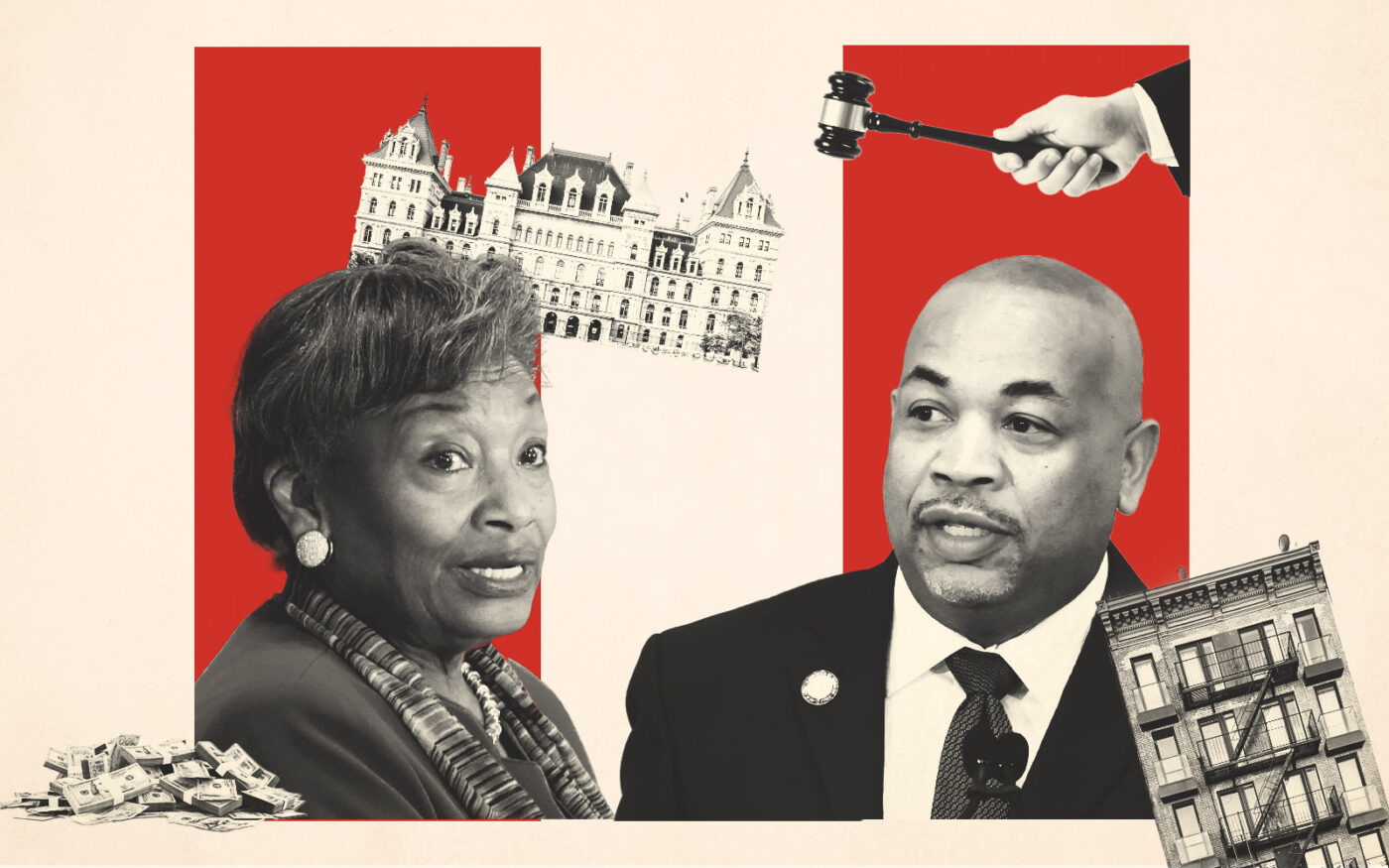 Hochul takes another crack at 421a, but throws curveball after speech
Hochul takes another crack at 421a, but throws curveball after speech
Trending
Here’s what the NY Senate real estate agenda does — and doesn’t — include
Budget resolutions set stage for 421a, good cause debate

The table is set in Albany. The menu includes a replacement 421a and tenant protections, but lawmakers haven’t agreed on what ingredients to use, how to accommodate allergies, or when the meal will be served.
In their budget resolution released late Monday, Senate Democrats once again excluded a replacement 421a. But they said they intend to address the expired property tax break as “part of a comprehensive housing package” that would also include “the core principles of good cause eviction.”
The Assembly’s version does not mention either the tax break or good cause eviction.
Rather than settling the long-standing tensions around these two policies, the Senate’s resolution only underscores the distance between the various stakeholders.
The resolutions are not binding, but serve as a starting point for budget negotiations.
Sen. Julia Salazar, a sponsor of the good cause eviction bill, has said the measure’s limitations on rent increases are negotiable, but that the “integrity of the bill” must be maintained. Other tenant advocates have objected to exempting certain landlords based on portfolio size or location. Leaders from outside the city signed onto a letter urging lawmakers against passing a “watered-down” version of good cause, according to Politico.
As for 421a, lawmakers said they are discussing a new program with “deeper affordability requirements, strong transparency and compliance provisions, and living wages for construction and building service workers.” Some lawmakers have called for prevailing wage requirements as part of the new program, but developers argue the proposed wage floor would make projects financially infeasible.
Meanwhile, Gov. Kathy Hochul’s executive budget outlined a new incentive program, but tasked the real estate industry and the construction trades with figuring out wage requirements, and the city’s housing agency with hashing out affordability levels for projects receiving the tax break. Dozens of lawmakers advised against this arrangement.
The Senate budget bill also states that the Senate is willing to discuss extending the June 2026 construction deadline for projects that vested under the former 421a.
Unlike last year’s one-house bill, the resolution indicates active discussions around reviving the tax break. The terms laid out, however, mirror those included in the housing deal that fell apart at the end of the last session.
The Senate’s resolution includes other top priorities for the Adams administration, such as lifting the city’s floor area ratio cap on residential buildings. The maximum FAR for residential use in the city is 12, meaning that a building can be 12 times the size of the lot. Lifting this limit does not automatically allow residential towers to exceed that limit: The city would still need to decide where larger buildings are permitted.
Still, the resolution specifies that any residential project larger than FAR 12 must adhere, at a minimum, to affordability requirements under the city’s Mandatory Inclusionary Housing program. The projects must also be located outside historic districts.
While the Senate resolution includes tax incentives for accessory dwelling units, it does not include a proposal to authorize the city to legalize basement and cellar apartments — something long sought by the city.
The measure also includes the governor’s proposal for a tax incentive for office-to-residential conversions, but requires 25 percent rather than 20 percent of converted apartments to be affordable. It also caps income levels for those units at 100 percent of the area median income. It specifies that the tax break would last 19 years, and sets rules for the benefit for south of 96th Street in Manhattan.
Industry professionals have bristled at the affordability requirements, citing the complexity of such projects, which adds costs.
The resolution also calls for the inclusion of $40 million in grant money to repair vacant, rent-stabilized apartments in New York City, as well as Nassau, Westchester and Rockland Counties. Lawmakers are willing to discuss increasing the cap on individual apartment improvements, which is $15,000 over a 15-year period.
Jay Martin, executive director of landlord group the Community Housing Improvement Program, said he appreciated that lawmakers recognized that owners of rent-stabilized housing are struggling, but called these provisions “insufficient.”
“In the past eight months, major regional banks have failed as rent-stabilized buildings have lost billions of dollars in value,” Martin said in a statement. “Thousands more apartments have entered into permanent vacancy. Hundreds of buildings have defaulted on loans. A growing number of buildings have stopped paying property taxes.”
CHIP has advocated for a bill that would allow landlords to increase rents more than is allowed now on vacant stabilized apartments that have been occupied continuously for 10 or more years.
The Assembly resolution seeks to codify the governor’s Pro-Housing Community Program and specifies that certified “pro-housing” communities should be given priority for certain funding before other programs. Meanwhile, Hochul wants to make funding available solely to those who are certified.
Both the Senate and Assembly include proposals to create a state housing voucher program. The real estate industry supports that, but points out that it doesn’t address the shortage of housing.
The Senate also added its own approach to the housing crisis by pitching a revamp to the Mitchell-Lama program, by creating a public benefits authority that would lease state-owned land back to developers, who would build affordable rentals and condos.
The Mitchell-Lama program was started in 1955 and led to the creation of 269 developments with more than 105,000 homes. The city seized properties through eminent domain and turned them over to developers who received low-interest loans and tax exemptions in exchange for keeping the housing affordable for between 20 and 35 years.
The program has faced criticism because many owners and shareholders opted to go market-rate over the years. City and state officials have also documented lapses in building oversight and maintenance.
Hochul has already proposed building up to 15,000 housing units on state-owned land. It is not clear how many apartments the Senate proposal would net.
Last month, Assembly member Emily Gallagher and Sen. Cordell Cleare introduced a bill that would similarly create a public benefit corporation, the Social Housing Authority. That agency would acquire property and finance housing using state funds and bonds. Limited equity co-ops, which are a type of housing created under Mitchell-Lama, was cited as one type of housing that could be created under the program.
Gallagher said she was “pleased to learn that the Senate majority conference has embraced the idea of creating a public developer for affordable housing.” The Assembly resolution pitches a “Foundations for Futures Housing” program, overseen by the state’s housing agency, to fund limited equity co-ops.
“But if we are going to address the scale of the housing crisis impacting New Yorkers, the new public authority needs to be capitalized with far more resources,” Gallagher said in a statement. “I believe the Social Housing Development Authority is the right approach.”
Read more
 Hochul takes another crack at 421a, but throws curveball after speech
Hochul takes another crack at 421a, but throws curveball after speech
 Which neighborhoods would change if density cap did?
Which neighborhoods would change if density cap did?
 “We cannot afford to get it wrong again”: Lawmakers criticize governor’s 421a placeholder
“We cannot afford to get it wrong again”: Lawmakers criticize governor’s 421a placeholder




